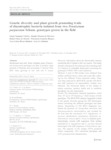Please use this identifier to cite or link to this item:
http://www.alice.cnptia.embrapa.br/alice/handle/doc/928955| Title: | Genetic diversity and plant growth promoting traits of diazotrophic bacteria isolated two Pennisetum purpureum Schum. Genotypes grown in the field. |
| Authors: | VIDEIRA, S. S.  OLIVEIRA, D. M. DE   MORAIS, R. F.   BORGES, W. L.   BALDANI, V. L. D.   BALDANI, J. I.   |
| Affiliation: | SANDY SAMPAIO VIDEIRA, UFRRJ; DANILO MESSIAS DE OLIVEIRA, UFRRJ; RAFAEL FIUSA DE MORAIS, UFRRJ; WARDSSON LUSTRINO BORGES, CPAF-AP; VERA LUCIA DIVAN BALDANI, CNPAB; JOSE IVO BALDANI, CNPAB. |
| Date Issued: | 2012 |
| Citation: | Plant and Soil Online, v. 356, n. 1-2, 2012. |
| Description: | Background and aims Some elephant grass (Pennisetum purpureum) genotypes are able to produce large amounts of biomass and accumulate N derived from BNF when growing in soil with low N levels. However, information about the diazotrophic bacteria colonizing this C4 plant is still very scarce. This study aimed to characterize the plant growth promoting traits of a fraction of culturable diazotrophs colonizing the genotypes CNPGL F06-3 and Cameroon. Methods A total of 204 isolates were obtained from surface sterilized leaves, stems and roots after culturing on five different N-free semisolid media. These were then analyzed by BOX-PCR, and the 16S rRNA and nifH sequences of representative isolates were obtained. The functional ability of the isolates to reduce acetylene, produce indole and to solubilize phosphate was also determined. Results The diazotrophic bacterial population varied from 102 up to 106 bacteria g?1 fresh tissues of both genotypes. The BOX-PCR analysis suggested a trend in the genetic diversity among the 204 diazotrophic strains colonizing the different genotypes and plant tissues. Sequencing of 16S rRNA fragments confirmed the presence of Azospirillum brasilense and Gluconacetobacter diazotrophicus and revealed for the first time the occurrence of G. liquefaciens, G. sacchari, Burkholderia silvatlantica, Klebsiella sp., Enterobacter cloacae and E. oryzae in elephant grass. Interestingly, several nifH sequences from isolates identified as G. liquefaciens and G. sacchari showed homologies with nifH sequences of Enterobacter species. The majority of the isolates (97%) produced indole compounds, 22% solubilized phosphate and 6.4% possessed both characteristics. |
| Thesagro: | Capim elefante Graminea forrageira Bactéria |
| Keywords: | Elephant grass |
| DOI: | DOI 10.1007/s11104-011-1082-6 |
| Type of Material: | Artigo de periódico |
| Access: | openAccess |
| Appears in Collections: | Artigo em periódico indexado (CPAF-AP)  |
Files in This Item:
| File | Description | Size | Format | |
|---|---|---|---|---|
| AP2012Geneticdiversityandplantgrowthpromoting.pdf | 271.94 kB | Adobe PDF |  View/Open |









